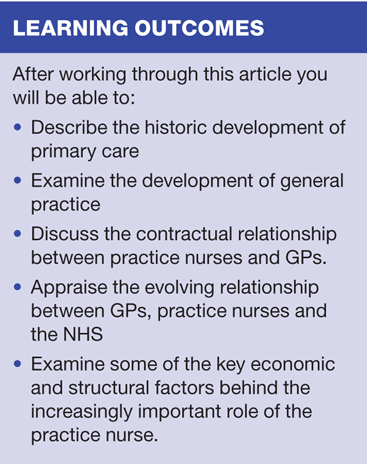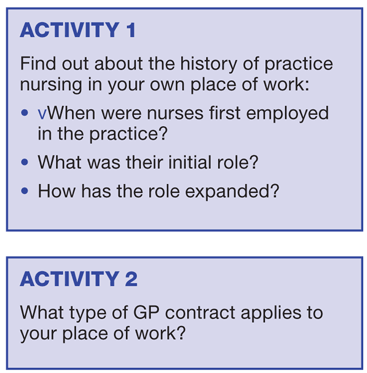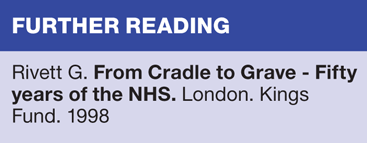Evolution of the role of nurses in primary care
Steve Ainsworth
Steve Ainsworth
Member of the Institute of Chartered Secretaries and Administrators and Institute of Healthcare Management
Freelance writer specialising in the history of medicine and the NHS
Lay Chairman of Independent Review Panels dealing with complaints about the NHS
Lay Panel Member for the Healthcare Commission
Lay Reviewer for the Royal College of Surgeons
General practice predates the NHS by almost a century and continues to evolve. Practice nursing is relatively new, but now practice nurses are integral members of the primary care team — and their role is still evolving
What, exactly, is primary care? At its broadest, primary care can be defined as every form of healthcare provision directly accessible to the patient — in contrast to secondary care, usually provided in a hospital setting, and accessible only when a patient has been referred to it by one of the 'gatekeeping' professions involved in the provision of primary care.
Primary care can thus be said to encompass not only doctors working in general practice and practice nurses, but also health visitors, district nurses, midwives, dentists, pharmacists, opticians and others.
More commonly, however, the term primary care is used to refer specifically to general practice and the services provided by healthcare professionals based in GP surgeries. This article tells the story of the evolution of general practice and explains the introduction and developing role of the practice nurse within that environment.
IN THE BEGINNING
It's usually said that the NHS began in 1948. This is both true and untrue. In fact the first National Health Insurance Act became law in 1911.
By then GPs, in their guise so familiar today, had been around for about a century. The profession of 'General Practitioner' arose from an amalgamation of two professions - general surgeons and apothecaries. Those apothecaries who decided not to become GPs became high street pharmacists instead.
GPs, usually working alone, were self employed professionals. Though they were often paid 'cash in hand' by patients, equally many were paid for having 'panel patients'. Throughout Britain a multitude of Friendly Societies existed, with millions of members.
The Friendly Societies (some of which still exist) administered not-for-profit insurance schemes. Payment of a small weekly sum entitled scheme members to the service of a GP. The doctor contracting with a Friendly Society was in turn paid an annual fixed sum for each patient registered on his (never a 'her' in this period) 'panel'.
Before the First World War the Chancellor of the Exchequer (later Prime Minister) Lloyd George thought this system for providing primary care so valuable he decided to make participation compulsory for all workers. The National Health Insurance Act of 1911 was introduced in addition to any Friendly Society activity. From then on weekly contributions were levied from every employee and every employer, with an equal 'top-up' from the Exchequer.
Those who were uninsured — housewives and children — continued to pay weekly sums to Friendly Societies, or took a risk and visited GPs on a 'pay as you go' basis.
This situation continued until 1948 when everyone came under the umbrella of the National Health Service: when the Secretary of State for Health, Aneurin Bevan, opened Park Hospital in Manchester, on 5 July 1948, it was the climax of a hugely ambitious plan to bring good healthcare to all. For the first time, hospitals, doctors, nurses, pharmacists, opticians and dentists were brought together under one umbrella organisation to provide services that were free to all at the point of delivery. Financed entirely from taxation, everyone could register for free treatment from a family doctor — a GP. Even prescriptions were free until 1952, when a charge of one shilling (5p) was introduced.
1965 AND ALL THAT
And where were practice nurses in all this? Well, nowhere at all. And the reason for what now seems such a strange omission lies in the way GPs used to be paid.
Fifty years after Lloyd George's National Health Insurance Act, GPs were still being paid in almost exactly the same way that they had been paid by Friendly Societies — a fixed annual sum per registered patient, paid quarterly. The entire General Practice payment system could be set out on a single sheet of paper. This archaic contract created 'perverse incentives'. In order to maximise their income GPs registered as many patients as possible while spending as little as they could on their surgery premises: as a result many surgeries were little more than an ill kept waiting room and a worse kept consulting room with no space for any practice staff.
Not that practice staff were much in evidence even in larger surgeries. Staff wages came directly from a GP's pocket, and as a consequence few GPs who had a spouse to answer the phone elected to employ any staff at all, let alone a practice nurse.
The problem came to a head in 1965 when disgruntled GPs took 'industrial action' with the aim of changing the terms of their contract with the NHS. The 'Doctors' Charter' introduced a plethora of changes to the way GPs were paid — most critically the direct reimbursement of the cost of providing surgery premises — and the partial reimbursement of the cost of employing up to two full time ancillary staff.
ATTACHED OR EMPLOYED?
The story of the following three decades would be one of physical expansion of GP surgeries. New and better financial incentives would progressively encourage GPs to build bigger and better surgeries — sometimes much bigger since financial incentives would also encourage GPs to form partnerships rather than continuing to practise in their traditional single-handed manner.
Meanwhile GPs had always been appreciative of nurses working in the community — if only because they relieved GPs of some of their own workload. Vey, very few GPs had actually employed nurses, however, before 1965. Indeed to begin with, even following the Doctors' Charter, few GPs employed nurses. Larger surgeries and shared local authority-owned Health Centres however did provide space for nurses to work more closely alongside GPs and for doctors to begin appreciating their work even more.
For many years GPs regularly campaigned to have district nurses directly attached to their practices. The downside of attachment however, at least from the GP's point of view, was that such nurses were not necessarily doing the tasks that the GP wanted them to do.
Eventually the penny dropped — if GPs wanted nurses to work in general practice the best solution was to employ them directly. In the early 1990s extra funding for reimbursing the cost of practice staff made it increasingly viable for GPs to employ practice nurses as well as their by now traditional non-clinical support staff such as receptionists and practice managers. Over the last twenty years, as a result of these cumulative changes, the number of practice nurses employed by GPs has soared.
NHS OR PRIVATE?
Do practice nurses work in the NHS? There is an important difference between working in the NHS and working for the NHS.
Back in the 19th century, where general practice has its roots, GPs were self-employed individuals with practices run rather like those of high street solicitors. The National Health Insurance Act changed that status not at all: GPs remained self employed individuals who simply provided private services for which they just happened to be paid by the state.
The arrival of the NHS in 1948 made no change to the self-employed independent contractor status of GPs. True, most of their income might be from the NHS, but they were certainly not NHS employees. The 'goodwill' value of their practices was no longer theirs to sell to an incoming practitioner, that 'asset' having been nationalised in 1948 — but they could still sell the practice premises to an incoming doctor. And true, they managed to have a bit of their cake and eat it by being allowed to participate in the NHS pension scheme. But, despite a close association with the NHS, GPs remained no more NHS employees than solicitors doing most of their business working for clients on Legal Aid were employees of the state.
Where then, did this leave practice staff, and in particular practice nurses?
If GPs are private sub-contractors to the NHS then their employees are in turn clearly one step even further removed from NHS employment — the private employees of a private healthcare provider.
For some nurses that may be an attractive notion — an escape from the sometimes suffocating hierarchy of the NHS structure.
Until just over 20 years ago nurses leaving an NHS post to take up a job working for a GP could not even continue in the NHS Pension Scheme. Happily that barrier or disincentive to career movement was removed. Yet such a move was nevertheless still emphatically outside the NHS with its standard terms of pay and conditions of service and grading structure.
Can a practice nurse really ever 'be' a band A,B,C, nurse etc. "¦ or band 1,2,3,4 or 5 etc.?
Do these NHS terms have any actual meaning in the 'private healthcare' world of general practice? Arguably they have no real meaning at all outside NHS employment. They simply provide a useful benchmark to establish a level of professional competency and 'pay equivalent to'. But as in every part of the private sector what is actually paid is ultimately down to personal negotiation between employee and employer. The fact that the NHS may reimburse the nurse's GP employer some, or even all of the cost of employment is normally of only indirect relevance to the contractual arrangement. Some practice nurses have become partners in GP practices. In principle a practice nurse, no matter what their qualifications, could easily be paid £100,000 a year or as little as £8 an hour.
Meanwhile, an underlying conundrum, still unresolved, is a policy conflict within Government and the Department of Health. Is it better for healthcare to be provided directly by NHS employees, or to be provided by private sub-contractors? Paradoxically, the options of both these opposing policies have been, and are being, pursued simultaneously. While much NHS activity is increasingly 'contracted out,' general practice has over the last 25 years been allowed, even encouraged, to enter an 'ever closer union' with the NHS. The once much-boasted of independence of GPs has passed through interdependence to become complete financial dependence upon the NHS.
THE BIGGER PICTURE
Why has the number of practice nurses risen so dramatically over the last two decades? To answer that question, one has to look at the bigger picture and understand several coincident developments. One is the decrease in the length of hospital stays, the consequent reduction in the number of hospital beds, and the matching increase in demand for 'care in the community'. At the same time demographics have also increased demand on primary care — more elderly patients means more work for GPs and their staff. Yet the willingness and ability of GPs to personally provide that care has actually declined.
Historically, the leadership of general practice was content to have a contract in which they were each on-call 24 hours a day. And independence was always more important than the security of a salaried job. By the late 1980s however times were a-changing. A new generation of GPs, very many of them now women, had no especial attachment to the idea of being an independent contractor. Many had no stomach for having to buy a share in practice premises. Nor, often with young families to care for, did they see any attraction in being contractually on-call at nights and weekends, or even being a full-time doctor.
More pairs of hands were needed at the coal-face, and practice nurses have in effect filled the gaps. Without it being obvious, they have substituted for those 'missing' GPs at considerably less cost than the alternative of training and recruiting thousands of additional doctors.
Another reason for the increase in practice nurse numbers was as a result of changes to the General Medical Services Contract in 1990. This removed the restriction on funding for just two ancilliary staff per doctor, and provided greater flexibility in the reimbursement of staff costs, allowing for the development and rapid expansion of the primary care team. The revised contract also provided financial incentives for 'Health Promotion,' which in turn encouraged GPs to take on more nurses to run clinics for everything from Well Woman and Well Man, smoking cessation — in fact, anything where a group of 10 patients could be gathered together. In addition, the contract encouraged GPs to provide chronic disease management clinics for diabetes and asthma, to bring the standards of 'the rest' up to those of 'the best'. GPs were also set targets for cervical cytology and childhood immunisations, so employed practice nurses to ensure these targets were met.
The 1990 General Medical Services Contract reinforced the need for GPs to do their own on-call, increasingly as part of practice-wide rotas, and occasionally in collaboration between practices, which led in the latter part of the decade to the development of out-of-hours co-operatives. But it wasn't until 2004, when the GP contract changed significantly, that GPs were able opt out of providing out of hours cover at little cost to themselves. The result has been 'GP-lite', with most GPs opting out of out-of-hours cover, and alternative providers employing nurses to triage out-of-hours calls. The other significant change in 2004 was the introduction of the Quality and Outcomes Framework (QOF) — and, since 2004, nurses have played a continuing and increasing role in ensuring that GPs achieve the annually revised QOF targets.
QUO VADIS?
Quo vadis — where are you going? The past is the only signpost we have to the future. As the working environment changes, so professions change and evolve in response.
The General Practitioner appeared in 1830 as a result of professional turf wars between the 'real doctors' of the Royal College of Physicians and general-surgeons and apothecaries. As for nurses, in the 1861 national census they were categorised as mere 'Domestic Servants'. Forty years later in the 1901 census they had moved up the social scale and were placed in the 'medicine' category of employment.
During the last century the professional status of both GPs and nurses has continuously risen — but their status has also changed in relative terms.
The emergence of the nurse practitioner and the prescribing nurse both make the emphatic point that the professional evolution of nursing in primary care is far from over. Meanwhile primary care itself continues to take centre stage in the delivery of healthcare — but whether Clinical Commissioning Groups succeed in delivering the current round of NHS reorganisation remains to be seen.
Though nothing in the future is certain, an increasing role for practice nurses is surely a better bet than most!
Related articles
View all Articles




